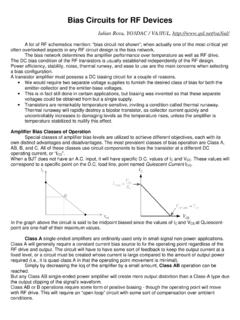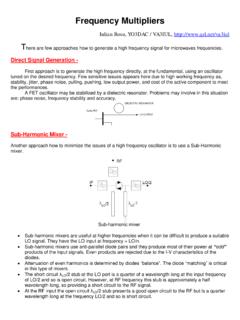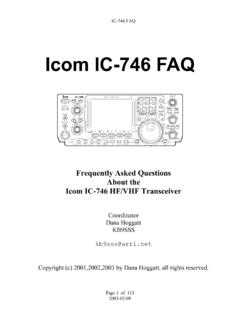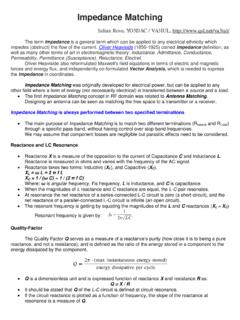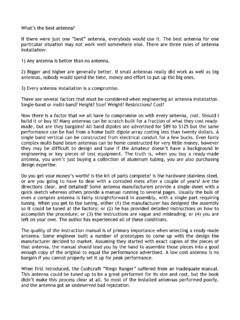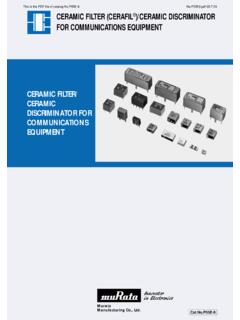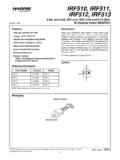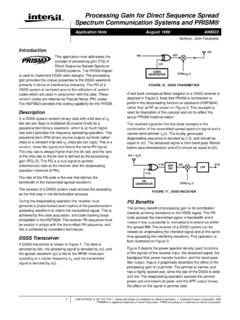Transcription of Microstrip, Stripline, and CPW Design - QSL.net
1 microstrip , stripline , and CPW Design Iulian Rosu, YO3 DAC / VA3 IUL, In the first years of microwave development the Rectangular Waveguide become the dominant waveguide structure largely because high-quality components could be designed using it. One of the main issues was its narrow bandwidth due to the cut-off frequency characteristic. Later, researchers try to find components that could provide greater bandwidth and possible miniaturization, and therefore they examined other waveguide types. Ridge Waveguide offered a step in that direction, having one or more longitudinal internal ridges that serve primarily to increase transmission bandwidth by lowering the cut-off frequency. Coaxial Line was very suitable, since it possessed a dominant mode with zero cut-off frequency, providing two important characteristics: very wide bandwidth, and the capability of miniaturization. The lack of a longitudinal component of field, made it more difficult to create components using it, although various novel suggestions were put forth.
2 In addition, those components would be expensive to fabricate. In an attempt to overcome these fabrication difficulties, the center conductor of the coaxial line was flattened into a strip and the outer conductor was changed into a rectangular box, and then fitted with connectors for use with regular coaxial line. At about the same time, Robert M. Barrett when working for the Air Force Cambridge Research Center in 1950s took a much bolder step. He removed the side walls altogether, and extended the top and bottom walls sideways. The result was called strip transmission line, or stripline . Like coaxial cable, stripline it is non-dispersive, and has no cut-off frequency. Different methods were used to support the center strip, but in all cases the region between the two outer plates was filled with only one single medium, either dielectric material or air. A modification that emerged almost in the same time involved removing the top plate leaving only the strip and the bottom plate with a dielectric layer between them to support the strip.
3 That structure was named microstrip . The first microstrip developments were done shortly after the appearance of Barrett s article, in 1952 by Grieg and Engelmann from the Federal Telecommunications Laboratories of ITT, presented as a competing printed circuit line. Because of the symmetry unbalance in microstrip , all discontinuity elements possess some resistive content and therefore make the line to radiate to some extent. At that time, regarding this radiation issue, additional remark was attempted to undermine the value of microstrip line as the basis for microwave components. So, the microstrip line was compared to an antenna, and it wasn t until about 15 years later, when the microstrip Patch Antenna was proposed, which was based on precisely the same concept. Types of Transverse Modes of Electromagnetic Waves TE, Transverse Electric waves, also referred as H-waves, are characterized by Ez = 0 and Hz 0 (no Electric field in the direction of the propagation).
4 TE waves can be supported inside closed conductors, as well as between two or more conductors. TM, Transverse Magnetic waves, also referred as E-waves, are characterized by Ez 0 and Hz = 0 (no Magnetic field in the direction of the propagation). Same as TE the TM waves can be supported inside closed conductors, as well as between two or more conductors. TEM means Transverse Electromagnetic mode since both Electric and Magnetic fields are transverse (perpendicular) to the direction of propagation. Ez = Hz = 0. TEM mode is also termed a differential mode, because the signal current flowing on the inner conductor is directed opposite to the ground current flowing on the outer conductor. The TEM mode has several unique characteristics: - At least two unconnected conductors and a single insulating material are required for it to exist. - Its cut-off frequency is 0 Hz. - It has only two field components (E and H) aligned with the transverse coordinates, no longitudinal (z-directed) Electric or Magnetic field component.
5 - Its propagation constant is the wavenumber in vacuum multiplied with the square root of the relative dielectric constant Er of the insulator. - In TEM mode, because of the symmetry of the structure, all discontinuity elements in the plane of the center strip are purely reactive. Quasi-TEM (Hybrid mode) has non-zero Electric and Magnetic fields in the direction of propagation. Hybrid modes are higher order modes with cut-off frequencies different from DC. (0 Hz) and are undesirable. These modes are a combination of both, the transverse electric (TE) and transverse magnetic (TM) modes and thus have the longitudinal components of both, the electric and the magnetic fields. The wave propagates in two different medias (air and dielectric) in a hybrid mode. Planar Transmission Lines One of the most commonly used transmission lines are the planar types which can be constructed precisely using low-cost printed circuit board materials and processes.
6 A number of these open, multiconductor transmission lines comprise a solid dielectric substrate having one or two layers of metallization, with the signal and ground currents flowing on separate conductors. Planar transmission lines used in microwave frequencies can be broadly divided into two categories: those that can support a TEM (or Quasi-TEM) mode of propagation, and those that cannot. For TEM (or Quasi-TEM) modes the determination of characteristic impedance and phase velocity of single and coupled lines reduces to finding the capacitances associated with the structure, and also the conductor loss can be determined in terms of variation of the characteristic impedance. Skin Depth of Planar Conductors At high frequencies, the current flowing in a conductor tends to get confined near the outer surface of the conductor. The higher the frequency, the greater the tendency for this effect to occur. The skin depth of a conductor is defined as the distance in the conductor (along the direction of the normal to the surface) in which the current density drops to 37% of its value at the surface (the current decays to a negligible value in a distance of about 4 to 5 skin depths).
7 The skin depth of perfect inductor (with Conductivity = ) is zero. The conductivity of normal metals (which are used in conductors) is high, although finite, so the skin depth is therefore very small at microwave frequencies. The frequency where the skin effect just starts to limit the effective cross sectional area of the conductor (equal to half the thickness of the trace) is called the crossover frequency. Skin depth is inversely proportional to the square root of the frequency. Skin depth does not depend on the shape of the conductor. Skin depth is a distance measured in from the surface of the conductor toward the center of the conductor. If skin depth is deeper than the center of the conductor, the current is not limited by the skin effect and the current is flowing uniformly throughout the entire cross sectional area of the conductor. Therefore, a thicker conductor is limited by the skin effect at a lower frequency than is a thinner conductor.
8 The skin effect, by changing the effective cross sectional area of a conductor, causes the effective resistance of the conductor to change with frequency. The skin effect is one of the two primary causes of losses in lossy planar transmission lines (the other is dielectric losses.). stripline Design stripline requires three layers of conductors where the internal conductor is commonly called the hot conductor, while the other two, always connected at signal ground, are called cold or ground conductors. The hot conductor is embedded in a homogeneous and isotropic dielectric, of dielectric constant r . So, unlike the case of microstrip , the word substrate is not appropriate since the dielectric completely surrounds the hot conductor. Section in a stripline Electric E and Magnetic H Fields The Electric-E and Magnetic-H field lines for the fundamental TEM mode in stripline are indicated above in a defined cross-section and a defined time.
9 Because the region between the two outer plates of stripline contains only a single medium, the phase velocity and the characteristic impedance of the dominant mode TEM do not vary with frequency. In the fundamental mode the hot conductor is equipotential (every point in it is at the same potential). stripline is often required for multilayer circuit boards because it can be routed between the layers, but grounding the stripline requires some care. If the top and bottom ground planes are not at the same potential, a parallel-plate mode can propagate between them. If excited, this mode will not remain confined to the region near the strip, but will be able to propagate wherever the two ground planes exist. stripline is more insensitive than microstrip to lateral ground planes of a metallic enclosure, since the electromagnetic field is strongly contained near the center conductor and the top bottom ground planes. As can be seen from the figure, in a stripline the return current path for a high frequency signal trace is located directly above and below the signal trace on the ground planes.
10 The high frequency signal is thus contained entirely inside the PCB, minimizing emissions, and providing natural shielding against incoming spurious signals. In the figure below, the parallel-plate mode is suppressed with metalized via holes connecting the two ground planes. The vias should be placed closely; a spacing s of one-eighth of a wavelength in the dielectric is recommended to prevent a potential difference from forming between the ground planes. In addition, such vias form a cage around the strip, in essence making it a basic coaxial line. When the vias are placed too close to the edge of the strip, they can perturb its characteristic impedance. The vias separation w should be a minimum of 3 strip widths, and 5 is preferable. If the via separation is too great, a pseudo rectangular waveguide mode can be excited. This mode has a cut-off frequency given by c/(2*w), where c is the speed of light in the dielectric.
